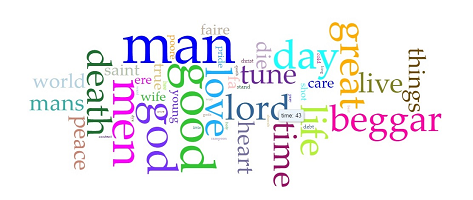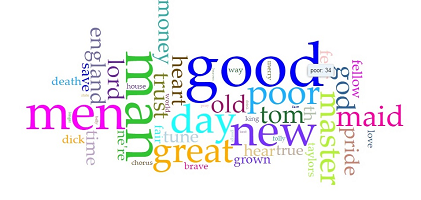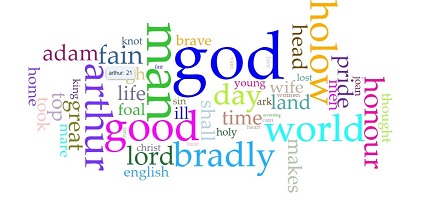Visualization of Women in Ballads

This word cloud comes from a corpus of thirty-seven broadside ballads out of an original corpus of one hundred and thirty broadsides that specifically mention women in some way. Even in ballads that discuss women, "men" and "man" are still prevent. The word's "man" and "wife" reflect the role people played for most of their lives. This also shows the religious norm of society by both god and pray, which show in the word clouds for the full one hundred and thirty ballad corpus. "Pride" appears nineteen times, while "vain" appears eighteen times in its different forms, though due to small numbers of each form, "vain does not show up in this word cloud. This visualization appears to show that broadside authors presented women most often in their traditional, socially-expected role as wife.

There are many similarities between the visualization that represents ballads that incorporate only broadsides that discuss the women, and the visualization that represents all one hundred and thirty ballads. Both of these word clouds show that "man," "men," and "god" are shown as some of the most used words. It is unsurprising that ballad authors show men as dominate in broadsides, as ballads often reflected or attempted to police early modern gender roles. The prevalence of "god" in broadsides also reflects that religion permeated all aspects of society. In the visualizations below, it also shows that ballad authors' discussion of God reflects the religious turmoil of the period. For instance, God is mentioned the most toward the end of James II's reign, when his daughter, Mary II, and son-in-law, William III, came to England to help remove James II from the throne.




In order to fully understand women's place in society during the seventeenth century, we need to closely examine how ballad authors referred to them. As the graph shows, "wife" is used the most in the thirty-seven ballads that mention women in some form. This reflects society's idea that all women at some point should marry to fully fulfill their role in society. "Maid" and "Maiden" are both used to indicate unmarried woman. In the ballads , "maid" most often refers to housemaid while "maiden" describes a unmarried woman. "Whore" or "Whores" are used less frequently but often used when describing a woman who transgresses social norms. "Mother" and "daughter" appear less frequently as which suggests that concerns about disorderly wives offered more entertaining material and caused more anxiety. The term, "Queen," rarely appears in the ballads as the last queen-regnant, Elizabeth I, died in 1603 and queens-consorts excited less interest.

This table shows the context in which women is used in the thirty seven ballads out of the one hundred and thirty used in this project that specifically mention women in some form. The way broadside authors use "women" in its different forms reflects society's perception of women is reflected in broadsides. Broadside authors wrote about women as either the example of the "ideal" women or as an example of how women should not act. These examples of how broadside authors showed "women" in context easily shows how women society often depicted during the seventeenth century.

The is table shows the context in which broadside authors use the term "whore" in the thirty-seven ballads that specifically mention women out of the one hundred and thirty used in this project. The broadside authors uses this term much less than other terms for women. This table shows that when broadside authors did use the term "whore" sporadically. The only constant is that the authors of broadsides are trying to convey that they are talking about the worst type of women in society and that these women are a threat to the order of society.
